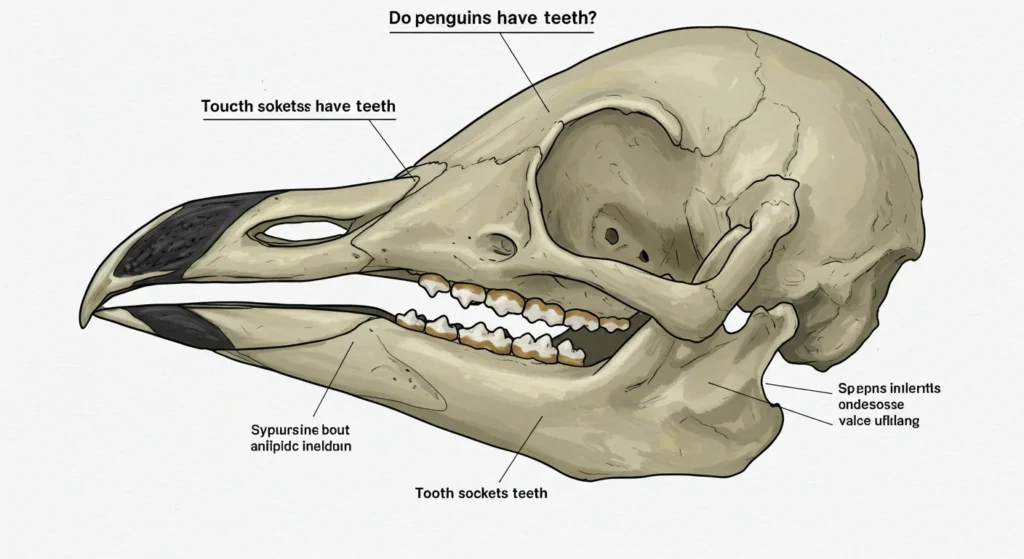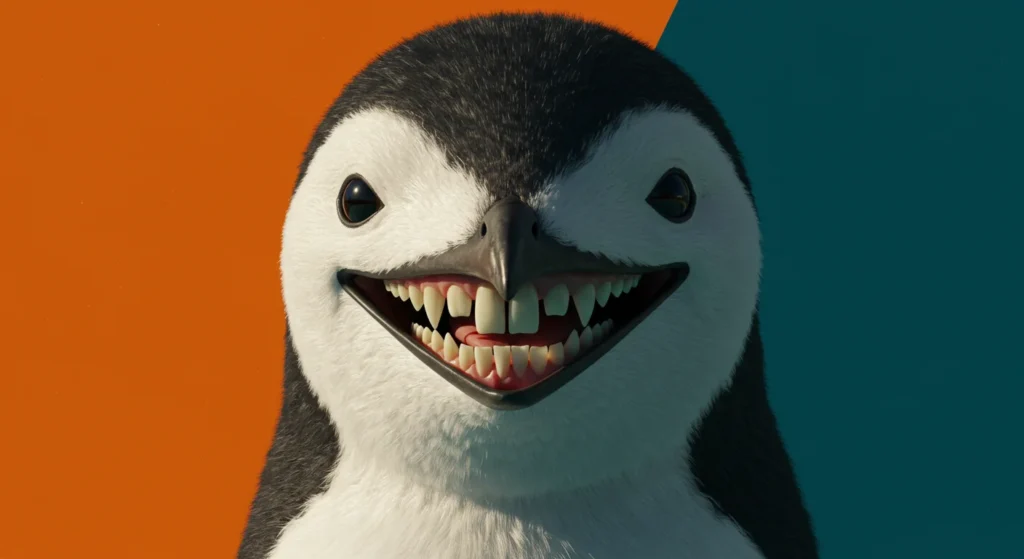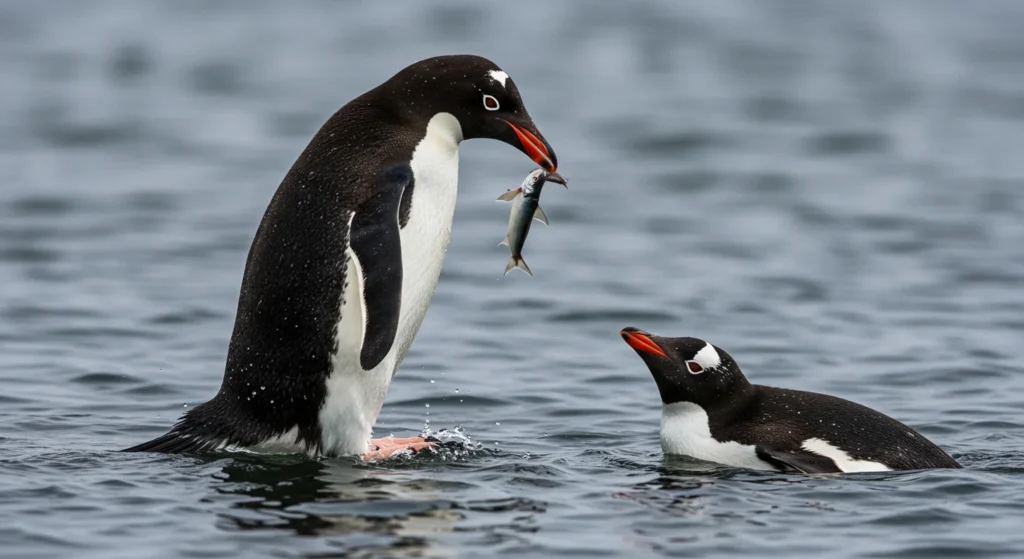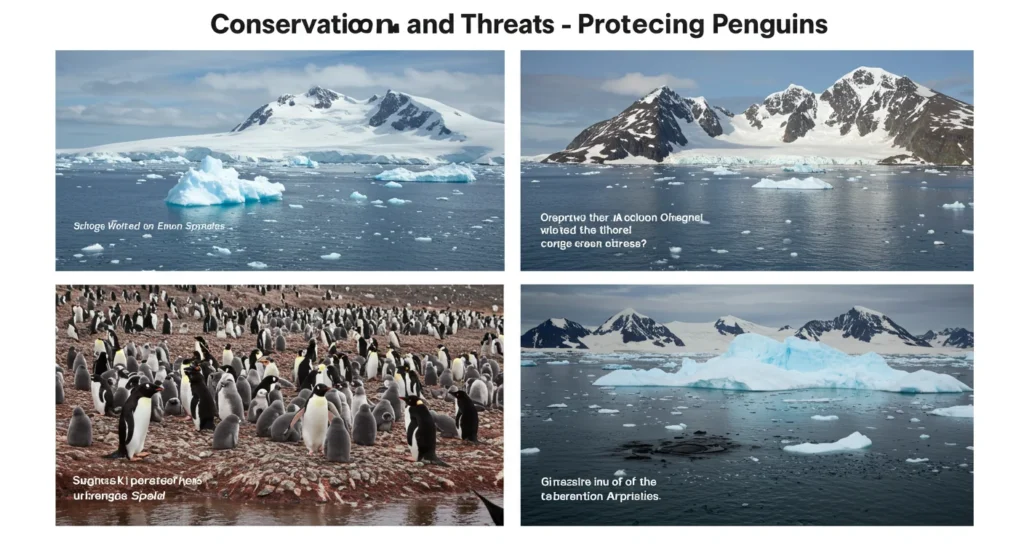Ever found yourself entranced by a penguin’s adorable waddle or their streamlined plunge into cold waters, only to question the idiosyncrasies of their biology? Among the numerous questions that pique interest, one prevails: “Do penguins have teeth? ” These flightless birds, with their tuxedo-feathered plumage and endearing personality, appear to conceal intriguing secrets within their physiology.
This guide unravels the mystery of penguin mouths, exploring their unique adaptations, feeding habits, and survival strategies. From the frozen slopes of Antarctica to the rocky shores of the Galápagos, we’ll uncover how penguins thrive without teeth and why their anatomy is a marvel of evolution. Expect a journey filled with surprising facts, practical insights, and a deeper appreciation for these incredible creatures. Consequently, you’ll see penguins in a whole new light by the end.
Key Takeaways:
- Penguins lack teeth but use papillae to grip prey.
- Their anatomy supports survival in extreme environments.
- Diet varies by species, relying on fish, krill, and squid.
- Conservation is crucial to protect penguins from threats.
Understanding Penguin Anatomy:
- Scientific Name: Order Sphenisciformes, Family Spheniscidae (e.g., Emperor penguin: Aptenodytes forsteri, Little Blue penguin: Eudyptula minor).
- Life Span: Averages 15–20 years; some, like Emperor penguins, may live up to 40 years in the wild.
- Size: Ranges from 30–33 cm (Little Blue penguin) to 1.3 m (Emperor penguin).
- Weight: Varies from 1.2–1.3 kg (Little Blue penguin) to 22–45 kg (Emperor penguin).
- Wingspan: Flipper span ranges from 60 cm (smaller species) to 89 cm (Emperor penguin).
- Status: Varies by species; e.g., Emperor penguins are Near Threatened, Galápagos penguins are Endangered (IUCN Red List).
- Diet: Carnivorous, including fish, krill, and squid; varies by species and habitat.
- Behavior: Social, often forming large colonies; expert swimmers and divers, with some species diving over 500 m.
- Habitat: Primarily Southern Hemisphere, from Antarctic ice (Emperor penguins) to temperate coasts (African penguins) and tropical islands (Galápagos penguins).
Penguins captivate us with their unique black-and-white feathers. Underneath this charming exterior is a body highly adapted for survival. Their physiology is the result of millions of years of evolution. Unlike mammals that live on land, penguins use specialized adaptations to catch prey and survive.

Do penguins possess teeth? No, they don’t. Rather, their mouths contain backward-facing spines known as papillae. These keratin structures on both the mouth and tongue serve as hooks to catch slippery animals like krill and fish. Their beaks are also curved and sharp and are meant to be precise for catching food while underwater.
“Penguins are a marvel of nature, perfectly adapted to their environment, with mouths designed not for chewing but for catching.” – David Attenborough
This adaptation proves vital for their aquatic lifestyle. Penguins spend up to 75% of their lives in water, diving for food in often turbulent seas. The papillae ensure prey stays caught, even in fast-paced underwater chases. Their anatomy also includes dense bones for diving and a streamlined shape for speed. Consequently, these features make penguins exceptional hunters and survivors.
Why Don’t Penguins Have Teeth?
Evolution has shaped penguins into effective sea animals. Conventional teeth, similar to mammals, are dense and require energy to produce and sustain. For penguins, diving hundreds of meters into cold oceans, added weight impairs performance.
They developed papillae instead—lightweight, rugged spines of keratin, the same substance as their beaks. They offer traction without the weight of teeth. In addition, penguins don’t masticate. Their bodies are designed to digest swallowed prey whole, making teeth obsolete.
This evolutionary adaptation improves their survival. Teeth may also be dangerous in freezing conditions, as they might crack due to extreme cold. Papillae, being tough and flexible, can better endure harsh conditions. Moreover, penguins’ ancestors probably lost teeth as they evolved to live in water, focusing on speed and efficiency. Thus, their toothless structure is a reflection of nature’s ingenuity.
How Do Penguins Eat Without Teeth?
Munching with no teeth would appear to be difficult. Penguins, though, have mastered this activity. Sharp and slightly hooked beaks, perfect for plucking prey such as fish or squid, do the job at first. Papillae on the inside of their mouths continue the process after capture.

The spines funnel food toward the throat, allowing escape. Papillae are also present on the tongue. It serves to push prey downwards in a conveyor belt fashion. This mechanism makes penguins efficient eaters in brief diving intervals.
“The penguin’s mouth is a testament to nature’s ingenuity, turning simplicity into strength.” – Jane Goodall
The Role of Papillae in Feeding:
Papillae deserve special attention for their critical role. These spines vary across penguin species, tailored to their diets and habitats. Emperor penguins, diving to depths of 500 meters, have dense, robust papillae to handle larger fish and squid.
Additionally, papillae assist in water filtration. When penguins catch prey, water often enters their mouths. The spines trap food while letting water escape, functioning like a natural sieve. This adaptation maximizes food intake during brief dives, which can last up to 20 minutes for some species. Hence, papillae are a cornerstone of penguin feeding success.
More For You: 12 Stunning Birds Similar to Peacocks (With Photographs)!
Penguin Diet – What Do They Eat?
Penguins are carnivorous, gorging on sea life such as fish, squid, and krill. Their diet depends on species and location. Adélie penguins, which inhabit Antarctica, subsist mostly on krill, which creates dense aggregations in cold waters. Galápagos penguins, found in warmer regions, prey on small schooling fish.

Emperor penguins, however, dive to catch larger prey, such as squid. Such dietary variation mirrors their capacity to fit into native environments. Their hunting technique is just as impressive. Penguins employ their keen vision and agility to chase their prey.
Some, such as the Gentoo, will dive more than 200 times per day in search of food. Their stomachs can stretch to accommodate several catches so that they may cache them in successful hunts. Their diet and hunting skills thus reflect their versatility.
Penguin Anatomy – Supports Survival without Teeth:
Penguins’ bodies are a masterclass in adaptation. Their feathers, overlapping like shingles, form a waterproof barrier and trap heat. Beneath the skin, a layer of blubber provides insulation and energy reserves for long fasting periods, such as during breeding. Their bones, denser than those of flying birds, aid in deep diving by reducing buoyancy. Additionally, their circulatory systems conserve oxygen.
Their flippers, modified wings, enable agile swimming. Penguins can maneuver with precision, dodging predators like leopard seals. Their countershaded coloring—dark backs and white bellies—serves as camouflage. These adaptations collectively ensure penguins thrive in extreme conditions, from Antarctic blizzards to tropical shores. Thus, their anatomy is a blueprint for resilience.
More For You: Cardinals Appear When Angels Are Near!
“Blessed are the meek, for they shall inherit the earth, much like penguins who humbly conquer the seas.” – Matthew 5:5 (Adapted)
Conservation and Threats – Protecting Penguins:
Oil spills and plastic litter contaminate their waters, with catastrophic consequences for populations. For instance, the 2000 Treasure oil spill off South Africa killed thousands of African penguins.
Conservation is being stepped up to resist these challenges. Marine protected areas protect feeding grounds. Institutions such as the WWF support sustainable fishing to maintain prey stocks.

Rehabilitation efforts save and treat oiled penguins, improving survival rates. Public campaigns also promote environmentally friendly behaviors. Thus, a collective effort is necessary to conserve penguins.
Saving penguins begins with tiny, tangible steps. Limiting the use of plastic reduces pollution in the oceans. Eating sustainably sourced seafood helps keep fish populations healthy. Contributing to organizations such as the Southern African Foundation for the Conservation of Coastal Birds (SANCCOB) pays for rescue operations.
Fascinating Facts About Penguin Anatomy:
- Feathers: Dense, waterproof feathers insulate and streamline for swimming.
- Bones: Dense bones aid diving; solid, unlike hollow bird bones.
- Flippers: Wing-like flippers propel efficiently underwater.
- Blubber: Thick fat layer provides warmth and energy storage.
- Feet: Webbed feet with claws for grip on ice and swimming.
- Eyes: Adapted for underwater vision, with flat corneas.
- Beak: Sharp, hooked for catching prey; varies by species.
- Heart: Slows during dives to conserve oxygen (bradycardia).
- Lungs: Efficient oxygen use; no air sacs like other birds.
- Salt Glands: Excrete excess salt from seawater consumption.
“In the simplicity of a penguin’s design lies the complexity of life’s greatest engineering.” – Sylvia Earle
Common Myths About Penguins –
Penguins are often misunderstood. Many believe they have teeth, a myth debunked by their papillae-based anatomy. Another misconception is that penguins only live in icy regions. While Antarctic species dominate popular imagery, Galápagos and African penguins inhabit warmer climates. Some think penguins are clumsy on land, yet their waddling conserves energy on slippery slopes.
These myths arise from limited exposure to penguin diversity. The media often focuses on cold-dwelling species, overshadowing tropical ones. Correcting these misconceptions fosters a deeper appreciation for their adaptability across varied ecosystems. Thus, understanding their true nature enhances our connection to these birds.
Frequently Asked Questions About Penguins:
Do Penguins Have Teeth on Their Tongue?
Penguins have no teeth, including on their tongues. Their tongues are lined with papillae, spiny structures made of keratin. These spines grip prey, guiding it toward the throat. Working with the mouth papillae, they ensure food doesn’t slip away. This adaptation supports their fast-paced underwater feeding. Thus, their tongues are toothless but highly functional.
Do Other Birds Have Similar Features?
Penguins share some traits with other seabirds but remain unique. Pelicans, for instance, lack teeth and use expandable beaks to scoop fish. Cormorants, also toothless, grip prey with hooked beaks.
Do Penguins Ever Sleep?
Penguins rest but don’t sleep like humans. They “loaf” on land, standing or lying to save energy. In water, they float or dive to relax. During breeding, Emperor penguins may endure weeks with minimal rest, showcasing stamina. Their rest patterns adapt to their demanding environments. Accordingly, sleep is flexible for penguins.
Do Penguins Have Feathers?
Yes, penguins have dense, waterproof feathers that insulate against cold. These feathers overlap tightly to streamline their bodies for swimming. They molt annually, replacing old feathers with new ones. Feather colors vary, often black, white, or with yellow accents.
Do Penguins Bite or Peck?
Penguins can bite or peck when threatened. Their sharp beaks deliver painful nips to predators or rivals. Pecking occurs during territorial disputes, especially in colonies. However, they prefer fleeing via agile swimming over confrontation. Their beaks are tools for feeding and defense. Thus, biting is a last resort.
Final Thoughts:
Penguins represent nature’s genius, living without teeth through clever adaptations. Their papillae, sleek bodies, and tough spirits are the epitome of survival masters. From frozen Antarctic oceans to warm tropical beaches, their tale fascinates and inspires.
Through studying their anatomy, diet, and plight, we move closer to these incredible birds. Conservation support means their legacy continues. The next time you catch sight of a penguin’s waddle, appreciate its toothless effectiveness—a small but impressive detail in a remarkable animal. Therefore, let us preserve them for generations to come.
